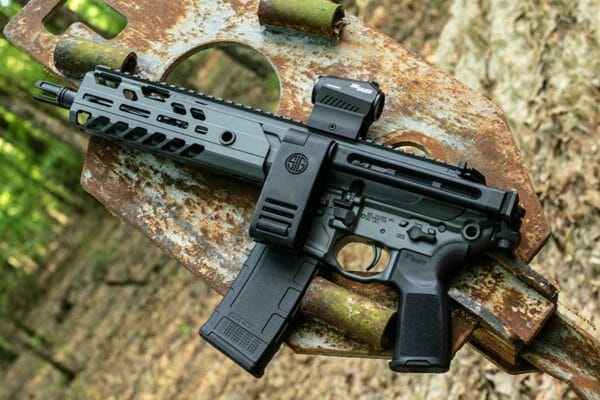
A three-judge panel from the Eighth Circuit Court of Appeals overruled a Federal District Court’s decision that upheld the Bureau of Alcohol, Tobacco, Firearms and Explosives (ATF) pistol stabilizing brace rule in the Firearms Regulatory Accountability Coalition (FRAC) v. Garland.
In a 2-1 decision, the court reversed the lower court’s ruling, stating that the plaintiffs were entitled to a preliminary injunction against the ATF’s Final Rule on pistol braces. Initially, the District Court ruled that the plaintiffs were not likely to succeed on the merits of the case. FRAC’s lawyers immediately appealed to the Eighth Circuit Court of Appeals, arguing that is likely to succeed on the merits because the ATF overstepped its authority when changing its long-standing opinion that adding a brace to a pistol doesn’t make that pistol a short-barreled rifle (SBR).
For years, the ATF held that pistols with stabilizing devices didn’t change a firearm from a pistol to a rifle, but the Biden Administration ordered the ATF to issue a rule reversing that ATF opinion. The ATF would acquiesce and present a proposed rule that would make most pistols equipped with a brace into an SBR. This change would mean millions of Americans could be charged with violating the National Firearms Act of 1934 (NFA) and face ten years in prison with a $250,000 fine. The punishment would be the same as being caught with an unregistered machine gun.
“Though the Final Rule does not ban stabilizing braces or braced weapons that are ‘short-barreled rifles,’ the consequences of possessing a braced weapon deemed to be a ‘short-barreled rifle’ are dire: that firearm and the person who possesses it are subject to the NFA’s and GCA’s stringent regulations and serious criminal penalties for non-compliance.” The judges wrote. “Considering the ATF estimated that by 2020 there were, at the low end, three million stabilizing braces in circulation (with seven million at the high end) plus an untold number of stabilizing braces sold between 2020 and the Final Rule’s publication in January 2023, then the Final Rule does the job of reclassifying these millions of braced weapons—and those who possess them—as violating the NFA and GCA.”
Multiple gun rights organizations filed several lawsuits to stop the rule from going into effect, including this one. Most were filed in the Fifth Circuit, where the Firearms Policy Coalition (FPC), the Second Amendment Foundation (SAF), and Gun Owners of America (GOA) would all receive injunctions against ATF enforcement for their members. Eventually, the Fifth Circuit of Appeals vacated the rule for everyone, causing the ATF to file for a writ of certiorari with The Supreme Court. Another case filed in the Eleventh Circuit seems to be facing the same fate as the other cases. FRAC, for its part, would lose at the District level before launching an appeal to the Eight Circuit Court of Appeals.
The Eight Circuit had findings similar to those of the Fifth Circuit. The ATF violated the Administrative Procedures Act (APA). A final rule doesn’t have to be identical to a proposed rule, but it does have to be a logical outgrowth of the proposed rule. This rule was not that. The final rule bore no resemblance to the proposed rule. The proposed rule had a worksheet (4999) that had a point system to help gun owners determine if their braced pistol was considered an SBR by the ATF. The final rule abandoned the whole point system and replaced it with a “you know it when you see it” test. The ATF’s statistics show that the rule reclassified 99% of braced pistols to SBRs. The Bureau could not provide one example of a braced pistol that wouldn’t be considered an SBR under the new rule.
The court also took issue with the ATF’s vague standards. The industry wanted some measurement of features such as surface areas to be able to produce stabilizing braces. The government refused to provide any information about its standards to prevent companies from designing and creating braces that would comply with the ATF’s new rule. The government viewed this attempt to develop compliant braces as “working around” the rule.
The judges took issue with the government’s stance on not issuing standards, ruling that the rule was incredibly vague. It is impossible to comply with standards unless you know them. The only way to see if you own an SBR is to have the ATF examine it. If they rule that the firearm is an SBR, then you just incriminated yourself. Most gun owners are not willing to take the risk.
This victory for FRAC is another in a long line of defeats for the ATF. The rule is already dead, but this is just another nail in the coffin, making it less likely to be revived. The ATF can request an en banc hearing in the Eighth, where the complete bench hears the case. If granted, the three-judge panel decision will be vacated, and the District Court’s decision will stand, but there is no guarantee that an en banc hearing will be granted. They could also ask the Supreme Court to step in, which is less likely.
John is an NRA instructor and a constitutional activist. John has written about firearms, interviewed people of all walks of life, and on the Constitution. John lives in Northern Virginia with his wife and sons and can be followed on Twitter at @crumpyss, or at www.crumpy.com.

from https://ift.tt/6Aulp8h
via IFTTT


No comments:
Post a Comment